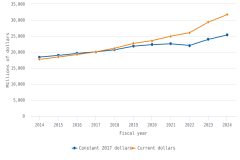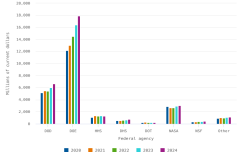R&D Spending at Federally Funded R&D Centers Surpassed $31 Billion in FY 2024
Federally funded research and development centers (FFRDCs) in the United States enable federal agencies to meet their research and development (R&D) needs through government-owned, contractor-operated research centers. These centers provide capabilities that cannot be met as effectively through other resources. The nation’s 42 FFRDCs spent $31.7 billion on R&D in FY 2024, an increase of $2.4 billion from the total reported in FY 2023 (table 1). A portion of this increase is due to the revised reporting methodology undertaken by the Idaho National Laboratory that was adopted to align with reporting practices of other Department of Energy laboratories. This revision contributed to a $963.9 million increase in reported R&D at the laboratory between FY 2023 and FY 2024. Total FY 2024 R&D expenditures at Idaho National Laboratory were $1.6 billion.
National Center for Science and Engineering Statistics, FFRDC Research and Development Survey.
Total reported R&D expenditures at FFRDCs increased from $17.7 billion in FY 2014 to $31.7 billion in FY 2024. In constant dollars, total FFRDC R&D expenditures rose an average of 3.3% annually from FY 2014 to FY 2024, which includes the Idaho National Laboratory FY 2024 adjustment (figure 1). (All amounts and calculations are reported in current dollars unless otherwise noted.) These and the other statistics in this report come from the FY 2024 FFRDC Research and Development Survey, conducted by the National Center for Science and Engineering Statistics (NCSES) within the U.S. National Science Foundation.
| Fiscal year | Constant 2017 dollars | Current dollars |
|---|---|---|
| 2014 | 18,377 | 17,719 |
| 2015 | 18,966 | 18,458 |
| 2016 | 19,564 | 19,220 |
| 2017 | 20,038 | 20,038 |
| 2018 | 20,698 | 21,172 |
| 2019 | 21,868 | 22,738 |
| 2020 | 22,318 | 23,514 |
| 2021 | 22,620 | 24,921 |
| 2022 | 22,034 | 26,007 |
| 2023 | 23,977 | 29,317 |
| 2024 | 25,333 | 31,725 |
In FY 2024, Idaho National Laboratory (INL) revised reporting methodology to align with reporting practices of other Department of Energy laboratories. INL now categorizes all work as research and development, except for manufacturing and for security and protection projects.
National Center for Science and Engineering Statistics, FFRDC Research and Development Survey.
R&D by Funding Source
Federal funding sources accounted for 98.5% ($31.2 billion) of FFRDC R&D expenditures in FY 2024. This level of support is typical for FFRDCs, which are privately operated R&D organizations that are exclusively or substantially financed by the federal government. Nonfederal sources funded the remaining R&D, which totaled $477.8 million: businesses ($239.7 million); nonprofit organizations ($52.7 million); state and local governments ($34.7 million); and all other sources ($150.6 million), such as funds from foreign governments and foreign or U.S. universities.
Federal Agency Sources of R&D Funding
Four agencies accounted for 92.0% of federally funded R&D expenditures at FFRDCs, which is typical: the Department of Energy (DOE), Department of Defense (DOD), National Aeronautics and Space Administration (NASA), and Department of Health and Human Services (HHS) (figure 2). DOE accounted for 57.3% ($17.9 billion) of federally funded R&D spending; DOD, $6.6 billion (21.1%); NASA, $3.0 billion (9.6%); and HHS, which includes the National Institutes of Health, $1.2 billion (4.0%). These four agencies were the only agencies with funding expenditures greater than $1 billion in FY 2024. FFRDCs identified 26 other agencies as sources of federal funding in FY 2024 (table 2).
| Federal agency | 2020 | 2021 | 2022 | 2023 | 2024 |
|---|---|---|---|---|---|
| DOD | 5,137 | 5,460 | 5,408 | 5,976 | 6,608 |
| DOE | 12,148 | 12,984 | 14,479 | 16,380 | 17,894 |
| HHS | 1,059 | 1,301 | 1,279 | 1,318 | 1,247 |
| DHS | 510 | 539 | 610 | 619 | 732 |
| DOT | 209 | 250 | 210 | 214 | 214 |
| NASA | 2,847 | 2,630 | 2,662 | 2,921 | 3,003 |
| NSF | 320 | 316 | 345 | 382 | 407 |
| Other | 905 | 1,030 | 968 | 1,068 | 1,140 |
DOD = Department of Defense; DOE = Department of Energy; DHS = Department of Homeland Security; DOT = Department of Transportation; HHS = Department of Health and Human Services; NASA = National Aeronautics and Space Administration; NSF = National Science Foundation.
National Center for Science and Engineering Statistics, FFRDC Research and Development Survey.
a Some funding sources were not identified for security reasons or because the original source was not known.
National Center for Science and Engineering Statistics, FFRDC Research and Development Survey, FY 2024.
DOD funded R&D at more FFRDCs than any other federal agency (29 centers), followed by DOE (25 centers) and NASA (23 centers) (table 3). DOD-funded R&D surpassed $1 billion at four FFRDCs in FY 2024, whereas DOE-funded R&D surpassed $1 billion at seven FFRDCs. Three FFRDCs accounted for at least 70% of their sponsoring agency’s total funding to FFRDCs in FY 2022:
- Jet Propulsion Laboratory accounted for 88.2% ($2.6 billion) of NASA-funded expenditures at FFRDCs ($3.0 billion).
- Center for Advanced Aviation System Development accounted for 76.4% ($163.8 million) of the Department of Transportation’s funding of FFRDC expenditures ($214.4 million).
- Frederick National Laboratory for Cancer Research accounted for 71.6% ($893.4 million) of HHS-funded FFRDC expenditures ($1.2 billion).
DOD = Department of Defense; DOE = Department of Energy; DHS = Department of Homeland Security; DOT = Department of Transportation; FFRDC = federally funded research and development center; HHS = Department of Health and Human Services; NASA = National Aeronautics and Space Administration; NSF = National Science Foundation.
National Center for Science and Engineering Statistics, FFRDC Research and Development Survey, FY 2024.
Expenditure Trends at Specific FFRDCs
The majority of FFRDCs (33 centers) increased R&D spending in FY 2024 compared with FY 2023; nine FFRDCs reported lower R&D totals in FY 2024 (table 4). Twelve FFRDCs reported more than $1 billion each (a combined $25.3 billion) in R&D expenditures for FY 2024—the NASA-sponsored Jet Propulsion Laboratory; eight DOE-sponsored national laboratories specializing in energy and the environment, national security, and nuclear science (Argonne, Idaho, Lawrence Berkeley, Lawrence Livermore, Los Alamos, Oak Ridge, Pacific Northwest, and Sandia National Laboratories); the DOD-sponsored National Security Engineering Center, Lincoln Laboratory, and Aerospace FFRDC. Sandia National Laboratories and Los Alamos National Laboratory were the two largest performers with $4.6 billion and $4.0 billion in total R&D, respectively. Between FY 2023 and FY 2024, Sandia National Laboratory increased its R&D expenditures by $359.5 million. Five other FFRDCs each increased their R&D expenditures between $112.0 million and $190.0 million: Los Alamos National Laboratory ($190.0 million), National Renewable Energy Laboratory ($180.0 million), Pacific Northwest National Laboratory ($159.6 million), Lawrence Livermore National Laboratory ($119.1 million), and Lincoln Laboratory ($112.0 million). As noted above, Idaho National Laboratory reported a significant increase in FY 2024 R&D expenditures ($963.9 million) due in part to a change in reporting methodology.
na = not applicable.
FFRDC = federally funded research and development center; NSF = National Science Foundation.
a Prior to the FY 2021 collection, the National Center for Science and Engineering Statistics discovered that the Green Bank Observatory had split from the National Radio Astronomy Observatory on 1 October 2016; both retained FFRDC status. For FY 2020, R&D expenditures reported for the National Radio Astronomy Observatory include the expenditures for the Green Bank Observatory. The Green Bank Observatory began reporting separately on the FY 2021 survey.
b In FY 2024, Idaho National Laboratory (INL) revised reporting methodology to align with reporting practices of other Department of Energy laboratories. INL now categorizes all work as research and development, except for manufacturing and for security and protection projects.
c The Judiciary Modernization Engineering Center was decertified as an FFRDC on 31 January 2021.
National Center for Science and Engineering Statistics, FFRDC Research and Development Survey.
Data Sources, Limitations, and Availability
The statistics on FFRDC R&D expenditures presented in this report come from the FY 2024 FFRDC Research and Development Survey. This annual survey is completed by FFRDC administrators and collects data from FFRDCs on R&D expenditures by source of funds (federal government, state and local governments, businesses, nonprofit organizations, or other); federal agency source; type of R&D (basic research, applied research, or experimental development); type of cost (salaries, software, equipment, subcontracts, other direct costs, and indirect costs); R&D personnel headcounts and full-time equivalents; and total operating budget. This survey has been a census of the full population of FFRDCs since FY 2001. For a list of criteria used to define the set of FFRDCs, see the general guidelines of the Master Government List of FFRDCs at https://ncses.nsf.gov/resource/master-gov-lists-ffrdc/general-notes.
The full set of data tables from this survey and more information on the survey methodology are available at https://ncses.nsf.gov/surveys/ffrdc-research-development/2024.
NCSES has reviewed this product for unauthorized disclosure of confidential information and approved its release (NCSES-DRN25-030).
Notes
1 The Master Government List of FFRDCs provides details on sponsoring agencies, administrator types, locations, and general and historical notes. See also Congressional Research Service. 2021. Federally Funded Research and Development Centers (FFRDCs): Background and Issues for Congress. Available at https://www.congress.gov/crs-product/R44629. Accessed 2025 June 27. And Cunningham JA and Link AN. 2022. The Returns to Publicly Funded R&D: A Study of U.S. Federally Funded Research and Development Centers. Annals of Science and Technology Policy: 6(3):228–314. Available at http://dx.doi.org/10.1561/110.00000023.
2 Idaho National Laboratory discovered that its project tracking logic was outdated because it was based on a discontinued Department of Energy Office of Scientific and Technical Information report. Idaho National Laboratory reassessed its methodology to classify non-R&D projects and report the remaining projects as R&D. This brought its reporting in line with other Department of Energy laboratories.
3 For FFRDC sponsoring agencies and locations, see table 6 in the full set of data tables.
Suggested Citation
National Center for Science and Engineering Statistics (NCSES). 2025. R&D Spending at Federally Funded R&D Centers Surpassed $31 Billion in FY 2024. NSF 25-351. Alexandria, VA: U.S. National Science Foundation. Available at https://ncses.nsf.gov/pubs/nsf25351.
Contact Us
National Center for Science and Engineering Statistics
Directorate for Social, Behavioral and Economic Sciences
U.S. National Science Foundation
2415 Eisenhower Avenue, Suite W14200
Alexandria, VA 22314
Tel: (703) 292-8780
FIRS: (800) 877-8339
TDD: (800) 281-8749
E-mail: ncsesweb@nsf.gov
 An official website of the United States government
An official website of the United States government



